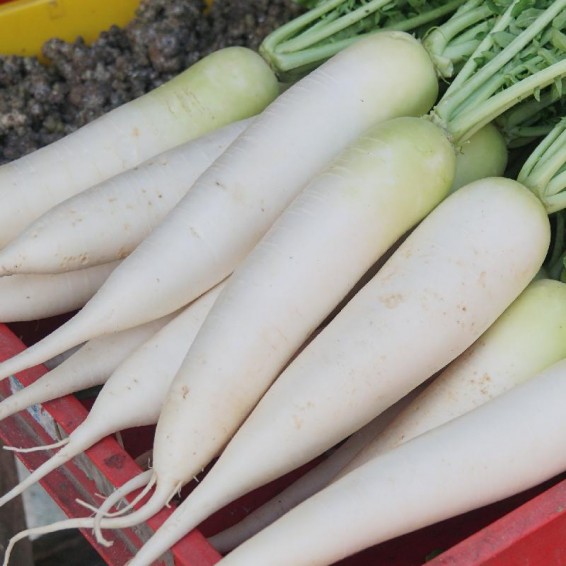Snow White Carrot Seeds
Daucus carota
- HOW TO GROW
- FAST FACTS
HOW TO GROW
Sowing: Prepare the soil 3 weeks before the last expected spring frost or when the soil temperature reaches 45 degrees F. These long, slender carrots appreciate deeply worked, loose soil in order to reach their full length. Build up a raised mound in the row, about 8" wide; sow the seeds on it, and cover them with 1/4" very loose soil. Keep the soil moist, but do not allow the area above Snow White carrot seeds to become hard - this may prevent the seeds from germinating. In cooler climates, sow more Snow White carrot seeds every 3-6 weeks for a continuous crop. Warmer climates may be restricted to spring and fall crops, since carrots cannot tolerate an excess of heat. For companion planting benefits, plant carrots with aromatic herbs or onions; this will repel the carrot fly and its maggots.
Growing: When the seedlings reach 2" high, gently thin them to 2-4" apart, depending on desired carrot size. The farther apart they are, the bigger they will grow. Do not allow the soil to dry out. When the tops of the carrots begin to emerge from the soil, cover them with mulch to keep them tender. Keep weeds under control to prevent the young carrots from being stunted.
Harvesting: Begin gathering baby carrots when grow big enough to eat, to allow the remaining carrots to reach a larger size. If they become difficult to pull, make sure the ground is moist. To store carrots for the winter, twist off the tops but do not wash them. Layer them in damp sand or sawdust. In warmer climates, leave the carrots in the garden over winter topped with a thick layer of mulch.
Seed Saving: Because carrot varieties will cross pollinate with each other as well as with wild carrots, isolate the plant for seed at least two miles from other varieties or provide a protective cage. In areas where the ground freezes over winter, it will be necessary to dig up the carrots before the first heavy frost; twist off the tops and store the carrots at 35 degrees F in damp sand or sawdust over winter, making sure the roots do not touch. Plant them again in the spring. From 30-40 carrots should be harvested to preserve genetic diversity. In warmer climates, leave them in the ground and cover them thickly with mulch over winter. In the spring, allow the top of the plant to flower; when they grow brown and dry, cut them off and allow them to fully dry. Clean to remove as much chaff as possible, then store Snow White carrot seeds in a cool, dry place for up to three years.
FAST FACTS
Latin Name: Daucus carota
Type: Open Pollinated, Cool Season
USDA Zones: 3, 4, 5, 6, 7, 8, 9, 10, 11, 12
Seeds per Ounce: 19,000
Planting Method: Direct Sow
Sunlight: Full Sun
Height: 16 Inches
Color: White
DESCRIPTION
HOW TO GROW
Sowing: Prepare the soil 3 weeks before the last expected spring frost or when the soil temperature reaches 45 degrees F. These long, slender carrots appreciate deeply worked, loose soil in order to reach their full length. Build up a raised mound in the row, about 8" wide; sow the seeds on it, and cover them with 1/4" very loose soil. Keep the soil moist, but do not allow the area above Snow White carrot seeds to become hard - this may prevent the seeds from germinating. In cooler climates, sow more Snow White carrot seeds every 3-6 weeks for a continuous crop. Warmer climates may be restricted to spring and fall crops, since carrots cannot tolerate an excess of heat. For companion planting benefits, plant carrots with aromatic herbs or onions; this will repel the carrot fly and its maggots.
Growing: When the seedlings reach 2" high, gently thin them to 2-4" apart, depending on desired carrot size. The farther apart they are, the bigger they will grow. Do not allow the soil to dry out. When the tops of the carrots begin to emerge from the soil, cover them with mulch to keep them tender. Keep weeds under control to prevent the young carrots from being stunted.
Harvesting: Begin gathering baby carrots when grow big enough to eat, to allow the remaining carrots to reach a larger size. If they become difficult to pull, make sure the ground is moist. To store carrots for the winter, twist off the tops but do not wash them. Layer them in damp sand or sawdust. In warmer climates, leave the carrots in the garden over winter topped with a thick layer of mulch.
Seed Saving: Because carrot varieties will cross pollinate with each other as well as with wild carrots, isolate the plant for seed at least two miles from other varieties or provide a protective cage. In areas where the ground freezes over winter, it will be necessary to dig up the carrots before the first heavy frost; twist off the tops and store the carrots at 35 degrees F in damp sand or sawdust over winter, making sure the roots do not touch. Plant them again in the spring. From 30-40 carrots should be harvested to preserve genetic diversity. In warmer climates, leave them in the ground and cover them thickly with mulch over winter. In the spring, allow the top of the plant to flower; when they grow brown and dry, cut them off and allow them to fully dry. Clean to remove as much chaff as possible, then store Snow White carrot seeds in a cool, dry place for up to three years.
FAST FACTS
Latin Name: Daucus carota
Type: Open Pollinated, Cool Season
USDA Zones: 3, 4, 5, 6, 7, 8, 9, 10, 11, 12
Seeds per Ounce: 19,000
Planting Method: Direct Sow
Sunlight: Full Sun
Height: 16 Inches
Color: White




